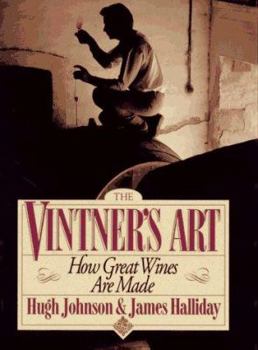Vintner's Art: How Great Wines Are Made
The skills used in the making of wine are directly relevant to the consumer, for the choices made in the vineyard and in the winery are crucial to the quality of the end product. Here, for the first... This description may be from another edition of this product.
Format:Hardcover
Language:English
ISBN:0671728881
ISBN13:9780671728885
Release Date:October 1992
Publisher:Simon & Schuster
Length:232 Pages
Weight:2.50 lbs.
Dimensions:0.9" x 8.4" x 11.1"
Related Subjects
Agricultural Sciences Cooking Cooking Drinks & Beverages Holiday Cooking Science & Math Spirits WineCustomer Reviews
5 ratings
Unique
Published by Thriftbooks.com User , 18 years ago
There are four main sources of flavor in wine. * The grape variety. * The place where it is grown. * The way in which it is grown * The winemaking techniques used. This valuable book is mostly about the last of these sources, although there is a brief nod to vineyard management at the beginning. You could argue for any of these sources as the primary source of wine's flavor and could easily produce pairs of wines that support your claim. Grape varieties, like apple varieties, have different flavors. These differences become accentuated when grape juice ferments into wine and produces or reveals its unique set of acids, esters, and other flavor chemicals. Vineyards have their own flavors, too. Apart from obvious considerations like sun exposure and soil structure, we know depressingly little about how this works. People who own the vineyards that produce the best wines often make a great deal of the unique contribution of their particular patch of ground, and we can hardly blame them. "Them" in this case is mostly the French, who use the word "terroir" to express this influence. Many of these winemakers consider their mission to be allowing their wine to `"express the nature of the terroir" Incidentally, all the possible jokes about "terroirists" have already been made. The management of grape vines in order to optimize flavor has been a realm of extreme conservativism until recently. Peasant farmers are understandably reluctant to undertake experiments when tradition is recognizeably safe. Winemaking techniques expand, contract, or radically alter the taste of wine. Some of these alterations - like prolonged contact between the freshly crushed juice and the grape skins or the choice of yeast - are in deliberate service to the flavors they produce. Others, like filtration and pasteurization, are driven by economic considerations and have secondary-and sometimes unfortunate-flavor consequences. It's the discussion of this last area-a matter often hinted at in other publications-that this book does so well. Taking each of eight categories of wine, the book discusses the winemaking choices that go into producing the characteristic taste of that category. So we have chapters on: Light-bodied Whites Wooded and Full-bodied Whites Sparkling Sweet Light-bodied Reds Medium-bodied Reds Full-bodied Reds Fortified Wines There is a brief section on the rôle of barrel storage, but it's far from complete. The description of winemakers' choices in this book is clear, extensive and beautifully presented. Their occasional snide remarks about New World winemaking should be taken lightly as a bit of Euro-Austro provincialism. Delightful reading for anyone who wants to know where all those great tastes come from. --Lynn Hoffman, author of THE NEW SHORT COURSE IN WINE and the forthcoming novel bang BANG from Kunati Books.ISBN 9781601640005
Winemakers Options
Published by Thriftbooks.com User , 22 years ago
Winemaking books come in three flavors. For beginners, some books present scores of 'home' recipies including fruits, veggies, meads, beers, & c. At the other extreme are advanced textbooks for enology courses. And in the middle are a few intermediate books that focus on simple wines, but without hinting all the vintner's options.Johnson and Halliday assume a basic knowledge of making and tasting wine and proceed to discuss all the options open to the winemaker. Simple charts depicting sequences of events are unique to this book and quite interesting.I still can't put it down. For a winemaker its a wealth of ideas and possibilities.
Excellent!
Published by Thriftbooks.com User , 25 years ago
James Halliday and Hugh Johnson do a fabulous job of explaining different wine styles and the reasons for the differences.Terrific photos and diagrams. A good read and an outstanding reference for winemakers and wine lovers. One oddity... they managed to write the book without using the word "zinfandel".
Excellent reference
Published by Thriftbooks.com User , 26 years ago
Found this book thoroughly delightful. A must for anyone interested in wines. Easy to read. Gives complete explanations about each wine type. Beautiful pictures, too. Keep it on my coffee table and refer to it regularly.
This book appeals to wine makers as well as enthusiasts.
Published by Thriftbooks.com User , 26 years ago
While this book will appeal to a broad audience of wine lovers, it will also have a special appeal to a narrower audience of wine makers. I count myself in both categories, so I'll offer two examples of this fine book's appeal: As a wine enthusiast, I discovered that New Zealand and South Africa are making wonderful Sauvignon Blanc. As a winemaker, I learned more about how Bordeaux winemakers derive the classic balance between approachable flavor and aging potential; and how the Australians use barrel fermentation of red wines to tame the assertive characteristics of their Shiraz. This is a MUST read for oenophiles!





